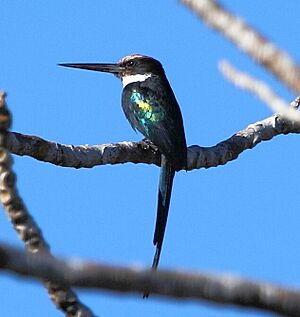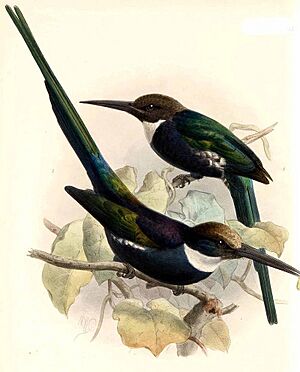Paradise jacamar facts for kids
Quick facts for kids Paradise jacamar |
|
|---|---|
 |
|
| at Novo Mundo, Mato Grosso State, Brazil | |
| Conservation status | |
| Scientific classification | |
| Genus: |
Galbula
|
| Species: |
dea
|
 |
|
| Synonyms | |
|
Alcedo dea Linnaeus, 1758 |
|
The paradise jacamar (Galbula dea) is a beautiful bird from the Galbulidae family, which includes jacamars and puffbirds. It lives in the warm, green forests of South America. You can find this bird in countries like Bolivia, Brazil, Ecuador, French Guiana, Guyana, Peru, Suriname, and Venezuela. These birds are known for their long, pointed beaks and bright, shiny feathers.
Contents
About the Paradise Jacamar
Naming and History
The paradise jacamar was first officially described in 1758 by a Swedish scientist named Carl Linnaeus. He was famous for creating the system we use today to name living things. Linnaeus first thought this bird was a type of kingfisher and gave it the name Alcedo dea.
He learned about the bird from an English naturalist, George Edwards. Edwards had described and drawn the "swallow-tail'd king-fisher" in his book in 1743. He had seen a bird from the Dutch colony of Surinam. Later, in 1760, a French zoologist named Mathurin Jacques Brisson created the genus Galbula for birds like the jacamar. The name Galbula comes from a Latin word for a small yellow bird. The word dea is Latin for "goddess," which fits such a lovely bird!
Different Types of Paradise Jacamars
Scientists recognize four different types, or subspecies, of the paradise jacamar:
- G. d. dea (Linnaeus, 1758) – This type lives in Venezuela, the Guianas, and Brazil (north of the Amazon River).
- G. d. amazonum (Sclater, PL, 1855) – You can find this one in northern Bolivia and southwestern Brazil.
- G. d. brunneiceps (Todd, 1943) – This type is found in eastern Colombia, eastern Peru, and western Brazil.
- G. d. phainopepla (Todd, 1943) – This subspecies lives in central western Brazil.
What They Look Like
The paradise jacamar is about 25.5 to 34 centimeters (10 to 13 inches) long. It weighs between 25 and 32.5 grams (about 1 ounce). Both male and female paradise jacamars have a dark brown head. The rest of their upper body is a shiny black. They have a white throat and upper chest, with the rest of their underside being blackish.
The different subspecies have slight differences in their looks. For example, G. d. amazonum has a lighter brown head and more white on its throat. G. d. brunneiceps has a lighter head and its upper feathers have a shiny bronze-green color.
Where They Live
The paradise jacamar lives mostly throughout the Amazon Basin, a huge area of rainforest in South America.
Here is where each subspecies is found:
- G. d. dea: From the upper Orinoco River in southern Venezuela, stretching east through the Guianas, and in Brazil north of the Amazon River.
- G. d. amazonum: In north-central Brazil, going south to northern Mato Grosso state, and northern Bolivia.
- G. d. brunneiceps: In southeastern Colombia, eastern Ecuador and Peru, and western Brazil (south of the Amazon and west of the Negro River).
- G. d. phainopepla: In western Brazil (south of the Amazon and west of the Madeira River).
These birds usually live in different types of forests, including both untouched forests and those that have grown back. They can also be found in dry forests and forests along rivers. You will most often see them along the edges of forests or in open areas like clearings. Unlike many other jacamars, they prefer to stay high up in the treetops, not in the middle levels of the forest. They are usually found below 500 meters (1,600 feet) in elevation, but sometimes they can be seen as high as 1,100 meters (3,600 feet).
Behavior and Life
What They Eat
The paradise jacamar mainly eats flying insects. Their favorite foods include butterflies, dragonflies, flies, and wasps. They sit on open branches, either alone, in pairs, or in small groups. When an insect flies by, they quickly dart out to catch it. Sometimes, they join groups of different bird species that are looking for food in the treetops.
Reproduction
Scientists have seen pairs of paradise jacamars digging nests in termite mounds found in trees. They are often seen near these nests. However, not much else is known about how these birds raise their young.
Sounds They Make
The paradise jacamar's song sounds like a series of "peep peep peep" notes. It usually starts strong and then gets a bit faster and softer towards the end. Their calls can sound like a single "pip," "peeap," or "glewweh."
Conservation Status
The IUCN (International Union for Conservation of Nature) has listed the paradise jacamar as a species of "Least Concern." This means that their population is not currently in danger. The number of paradise jacamars can vary from rare to common across their wide range. They have been seen in many protected areas. While there are no immediate major threats, the ongoing destruction of their forest homes could reduce their numbers in the future.



